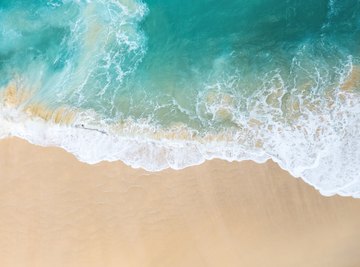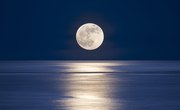
Since prehistoric times, people have intuitively known that the moon and the tides are connected, but it took a genius like Isaac Newton to explain the reason.
It turns out that gravity, that mysterious fundamental force that causes the birth and death of stars and the formation of galaxies, is primarily responsible. The sun also exerts a gravitational attraction on the earth, and it contributes to ocean tides. Together, the gravitational influences of the sun and the moon help determine the types of tides that occur.
While gravity is the number one cause of tides, the earth's own movements play a part. The earth spins on its axis, and that spinning creates a centrifugal force that tries to push all the water off the surface, much as water sprays away from a spinning sprinkler head. The earth's own gravity prevents the water from flying off into space.
This centrifugal force interacts with the gravitational pull of the moon and sun to create high tides and low tides, and it's the main reason that many places on Earth experience two high tides every day.
The Moon Affects Tides More than the Sun
According to Newton's Law of Gravitation, the gravitational force between any two bodies in the universe is directly proportional to the mass of each body (m1 and m2) and inversely proportional to the square of the distance (d) between them. The mathematical relationship is as follows:
F = Gm1m2/ d2
where G is the universal gravitational constant.
This law reveals that the force depends more on distance than it does on relative masses. The sun is much more massive than the moon – about 27 million times as massive – but it's also 400 times farther away. When you compare the gravitational forces they exert on the earth, it turns out that the moon pulls about twice as hard as the sun.
The sun's influence on tides may be less than that of the moon, but it's far from negligible. It's most apparent when the sun, earth and moon line up during the new moon and full moon. At full moon, the sun and moon are on opposite sides of the earth, and the highest tide of the day isn't as high as normal, although the second high tide is a little higher.
At new moon, the sun and moon are lined up on the same side of the earth and their gravitational pulls reinforce each other. The unusually high tide is known as the spring tide.
The Moon's Gravity in Combination with the Centrifugal Force
The centrifugal force caused by the earth's rotation on its axis gets a boost from the moon's gravity, and that's because the earth and moon rotate around each other.
The earth is so much more massive than the moon that it appears that only the moon is moving, but actually both bodies are rotating around a common point called the barycenter, which is 1,068 (1,719 km) miles below Earth's surface. This creates an additional centrifugal force, much as a ball spinning on a very short string would experience.
The net effect of these centrifugal forces is to create a permanent bulge in the earth's oceans. If there were no moon, the bulge would never change, and there would be no tides. But there is a moon, and here's how its gravitation affects the bulge at a random point A on the spinning earth:
- Midnight: Point A is facing the moon, and the combination of the moon's gravitational pull and the centrifugal bulge combine to create the high tide.
- 6 a.m. and 6 p.m.: Point A is perpendicular to a line between the earth and the moon. The normal component of its gravitational force counteracts the centrifugal bulge and pulls it in. Point A experiences low tide.
- Noon: Point A is on the opposite side of the earth from the moon. The moon's gravitation is weaker because point A is now one earth diameter away, which is almost 8,000 miles (12,875 km). The gravitational force isn't strong enough to neutralize the centrifugal bulge, and point A experiences a second high tide, which is smaller than the first one that occurred at midnight.
The moon moves through the sky at an average rate of 13.2 degrees per day, which corresponds to about 50 minutes, so the first high tide on the following day occurs at 12:50 a.m., not midnight. In this way, the timing of the high tides at point A follows the motion of the moon.
The Sun's Effect on Ocean Tides
The sun has an effect on tides analogous to that of the moon, and even though it's half as strong, anyone predicting sea tides has to take it into account.
If you visualize the gravitational effects on tides as elongated bubbles surrounding the planet, the moon's bubble would be twice as elongated as that of the sun. It rotates around the earth at the same speed as the moon orbits the planet while the sun''s bubble follows the motion of the earth around the sun.
These bubbles interact like interfering waves, sometimes amplifying each other and sometimes canceling each other.
The Earth's Structure Also Affects Ocean Tides
The tidal bubble is an idealization, because the earth isn't completely covered by water. It has land masses that confine the water into basins, so to speak. As you can tell by tilting a cup of water back and forth, water in a container behaves differently than water that is unconfined by borders.
Move the cup of water one way, and all the water sloshes to one side, then move it other way, and the water sloshes back. Ocean water in the three main ocean basins – the Atlantic, Pacific and Indian oceans – as well as in all the smaller ones, behaves the same way because of the earth's axial spin.
The motion isn't as simple as this, because it's also subject to winds, water depth, coastline topography and the Coriolis force. Some coastlines on Earth, particularly those on the Atlantic coast, have two high tides per day while others, such as many places on the Pacific coast, have only one.
The Effects of Tides
The regular ebb and flow of the tides has a profound effect on the coastlines of the planet, continually eroding them and changing their features. Sediment is carried on the retreating tide out to sea and deposited anew in a different place when the tide comes back in.
Marine plants and animals in tidal areas have evolved to adapt to and capitalize on this regular movement, and fishermen throughout the ages have had to time their activities to conform to it.
The movement of the tides generates an enormous amount of energy which can be converted to electricity. One way of doing this is with a dam that uses the movement of water to compress air to drive a turbine.
Another way is to set up turbines directly in the tidal zone so that the retreating and advancing water can spin them, much like the wind spins air turbines. Because water is so much denser than air, a tidal turbine can generate significantly more energy than a wind turbine.
References
- National Oceanic and Atmospheric Administration: Detailed Explanation of the Differential Tide Producing Forces
- University of Hawaii: Tide Formation—Gravitational Pull
- Universe Today: The Sun and the Moon
- NASA: Ocean Motion
- Virginia Institute of Marine Science: The Equilibrium Theory of Tides
- U.S.Army Corps of Engineers: Coastal Effects of Tides
About the Author
Chris Deziel holds a Bachelor's degree in physics and a Master's degree in Humanities, He has taught science, math and English at the university level, both in his native Canada and in Japan. He began writing online in 2010, offering information in scientific, cultural and practical topics. His writing covers science, math and home improvement and design, as well as religion and the oriental healing arts.
